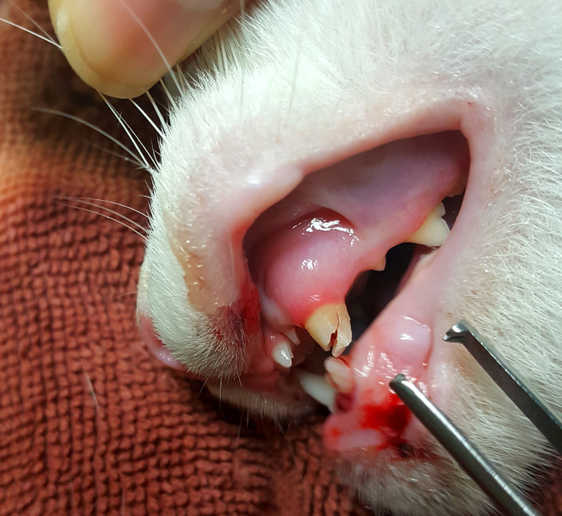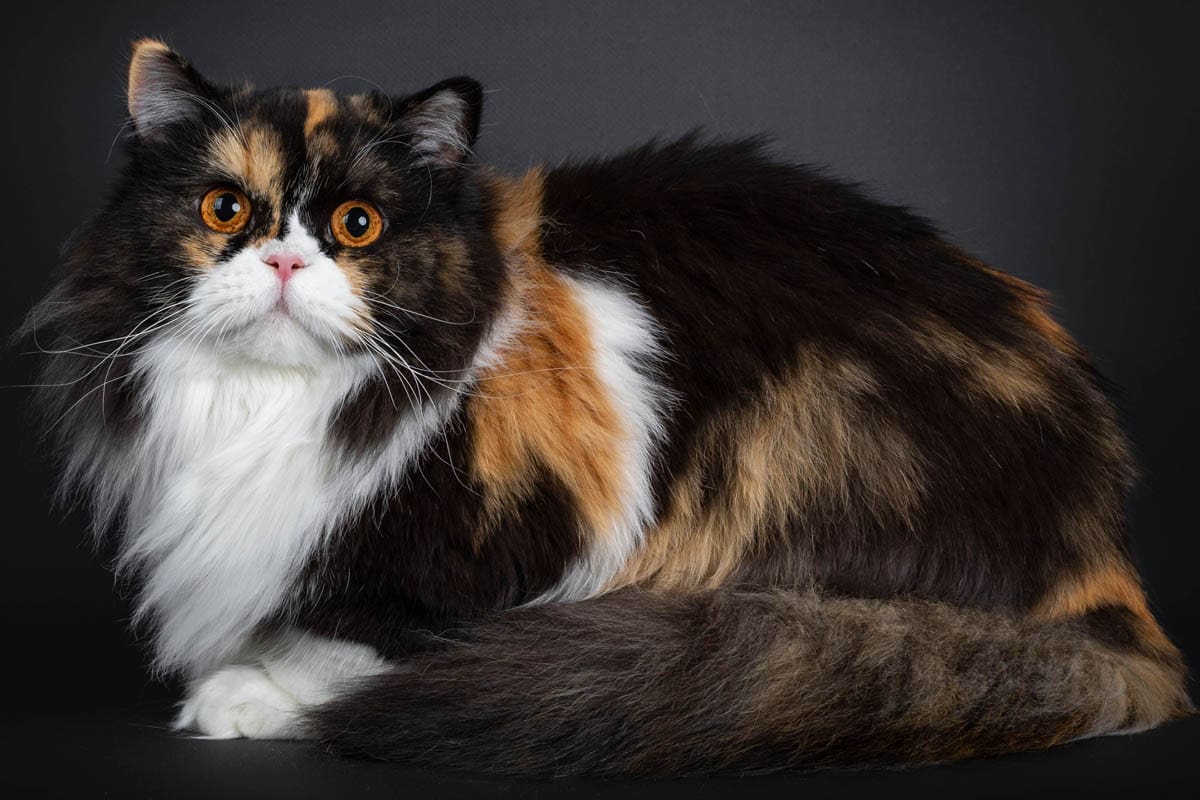Bleeding in cats may be a minor incident or a major one. The amount of bleeding and the location of the bleeding all play a factor in the seriousness of the condition. If in any doubt, it is always a good idea to speak to your veterinarian. Many cases of bleeding have a simple cause and are not life-threatening, however, some do have serious causes. Let’s look at the details, with the help of Dr. Jamie Whittenburg, our lead veterinarian here at Cat World, and Director of Kingsgate Animal Hospital in Lubbock, Texas.
Cat bleeding from a wound
A wound over 1 inch long requires veterinary attention, smaller wounds can be treated at home if they are not deep or bleeding too heavily. First, you should apply gentle pressure on the wound to stop the bleeding. Once bleeding has stopped, use a syringe (without the needle) filled with a flush such as sterile saline to clean the wound out. Gently pat dry. Don’t use hydrogen peroxide or Dettol on cat wounds.
Topical antibiotics such as Neosporin should not be applied to cat wounds. Cats will lick the product and may experience toxicity.
Keep an eye on all wounds to make sure they are healing well. If you notice any redness, swelling, discharge, or odor, seek veterinary attention as it may have become infected.
Cat bleeding from the mouth:

There are several reasons why your cat may be bleeding from the mouth. There may be an injury to the mouth, tongue, teeth, etc., or the blood could be coming via an internal wound or disorder. Common causes of mouth bleeding from the mouth include:
- Broken tooth – A broken tooth may bleed bright red blood and cause hypersalivation. A broken tooth is very painful and requires prompt veterinary attention.
- Dental abscess – Cats may suffer from an infection of the roots of their teeth. Oral pain, reluctance to eat, hypersalivation, and blood may all be seen. Because this is a painful condition and may also lead to the cat not eating well, a dental abscess requires an urgent trip to the veterinarian.
- Periodontal disease Disease of the gums and teeth resulting from tartar and bacterial accumulation is incredibly common in cats. You may see bloody saliva and appreciate a foul smell from the mouth.
- A foreign body lodged in the mouth – Cats may ingest sharp objects such as needles, stickers, and fish hooks that become lodged in the mouth. The most common presentation is a cat that is reluctant to eat and has red blood-tinged saliva.
- Toxicity There are certain toxins that may cause bleeding in a cat that may be seen in the mouth. If your cat has been potentially exposed to a toxin, you should take them to the nearest veterinarian immediately.
- Trauma – Injuries to the mouth may result in bright red blood or blood-tinged saliva. If blood is observed, it is likely the injury needs to be seen by a veterinarian.
- Stomatitis – Cats often suffer from a serious autoimmune-related inflammation of the mouth and pharynx. These cats often have bad breath, pain when eating, and bloody saliva. Treatment is needed to control this disease.
- Internal bleeding – Cats that are suffering from internal bleeding may vomit red, brown, or black blood. This is an emergency.
- Cancer – There are a number of cancers that primarily occur in the mouth in cats. A cat with cancer in their mouth will typically paw at the mouth, eat less, and hypersalivate. Blood may be seen in the saliva.
If my cat is bleeding from the mouth, how serious is it, and can it be fatal?
There are many, many things that may cause blood to be seen in a cat’s mouth. The vast majority of these issues are urgent and need to be seen by a veterinarian as soon as possible. The reason for quick intervention is two-fold; all of these diseases or injuries are painful, and cats are prone to life-threatening hepatic lipidosis if they don’t eat. There is also a possibility of fatality when a cat is seen bleeding from the mouth. All cats with bleeding in the mouth should be seen by a veterinarian as soon as possible.
Cat bleeding from the nose (epistaxis)
Most cases of nosebleeds are due to trauma or blow to the face. Other causes include:
- Foreign body
- Trauma
- Broken capillary
- Cancer
- Dental abscess
- Blood clotting disorder (low platelet count) due to parasites or anemia
- Infections (viral, bacterial, fungal)
Because epistaxis can be a sign of a life-threatening condition, it should always be taken seriously. A cat with a bleeding nose should be seen as soon as possible by their veterinarian.
If the cause of sneezing can’t be easily determined, your veterinarian may need to perform x-rays, a CT scan, or nasal endoscopy to look for a possible foreign body lodged deep in the nasal cavity. Blood tests may be needed to check for anemia and infection and to evaluate overall health.
Cat bleeding from both the mouth and the nose
- Because the nose and mouth are close in proximity, it is possible for a bloody nose to appear to also be coming from the mouth and vice-versa. However, any cat that truly has blood coming from their nose and mouth is likely severely injured or ill and must be taken to the nearest emergency hospital right away.
Cat bleeding from eyes
- Blood exiting the eye or eyes of a cat is most likely due to trauma and is an emergency. This cat should be taken to a veterinarian immediately. Blood in the chamber of the eye or in the sclera (white portion) of the eye can be due to trauma, infections, eye disorders, and clotting issues. These cats should receive veterinary care as soon as possible.
Cat bleeding from an ear
Causes of bleeding from the ear may include:
- Ear hematoma
- Laceration
- Injury to the ear caused by scratching due to ear mites
- Foreign body
- Cancer
- Trauma
There is a difference between bleeding from the outer ear (pinna) and blood truly exiting the ear canal. Check the ear for lumps and bumps. Ear mites have the appearance of coffee grounds. They cause intense itching, which results in damage to the ear. Ear hematomas are a collection of blood under the skin, usually caused by trauma.
If the ear has been cut, and the bleeding/wound isn’t too severe, you should be able to treat this at home using the methods described above for cat wound treatments.
If you notice any lumps, bumps, growths, or odor coming from the ear, prompt veterinary attention is required.
Ear mites will need to be treated with an anti-parasitic medication, and if the ear is infected, a course of antibiotics may be required.
If blood is seen truly exiting the ear canal, this is a true emergency, and the cat must be taken to a veterinarian immediately.
Cat bleeding from the anus
See your veterinarian if your cat has anal bleeding. Possible causes of bleeding from the anus include:
- Straining to defecate, which can cause tears
- Anal gland abscess or infection
- Cancer
- Anal polyps
- Toxicity
- Blood clotting disorders
Is the blood actually coming from the anus, or is it on/in the stool? Has your cat had access to poison? Has the cat been straining to defecate recently? Are there other symptoms? These are all questions your veterinarian will ask, and each issue will require a different treatment.
Cat bleeding from a claw
Bleeding from the claw is usually caused by injury or accidentally cutting the claw too short. Is one claw bleeding or several? Car accidents often lead to claw injuries, so even if your cat appears to be well if multiple claws are bleeding and injured, veterinary attention should be sought.
If you have trimmed the claw too short, then this is something that can easily be treated at home. Either a styptic pencil or ordinary household flour can be used on the claw to stop the bleeding. As you can imagine, the claw will be a little sore for a day or so afterward.
Cat bleeding after giving birth?
A small amount of blood is expected after your cat gives birth, but if this bleeding lasts more than a day or is heavy, immediate veterinary attention is required. It could mean that a kitten or placenta has been retained, or there is an infection of the uterus. These can be life-threatening.
Other symptoms to watch for:
- Loss of appetite
- Weakness
- Odor
- Fever
Treating bleeding in cats
- Treating bleeding in cats is entirely dependent on the cause of the bleeding. If your cat is actively bleeding, you should attempt to stop the flow of blood, if possible, and take them to a veterinarian urgently.
Tips to stop bleeding in cats
- Attempting to stop bleeding in a cat can be important after an injury. If possible, firm but gentle pressure should be applied to the area that is bleeding. Caution should be used as a painful cat may not realize that you are trying to help, and they may bite you. You should never attempt to place a tourniquet on a cat without veterinary supervision, and severe damage is likely to occur. A bleeding cat should be taken to an emergency veterinary hospital immediately.


